Java BirdThe Java sparrow (Padda oryzivora) is a tiny passerine bird that is also referred to as the Java finch, Java rice sparrow, or Java rice bird. This beautiful finch breeds on the Indonesian islands of Java, Bali, and Bawean. It is a renowned cage bird that is now widely available in various nations. Some taxonomists classify this and the Timor sparrow as members of the genus Padda. 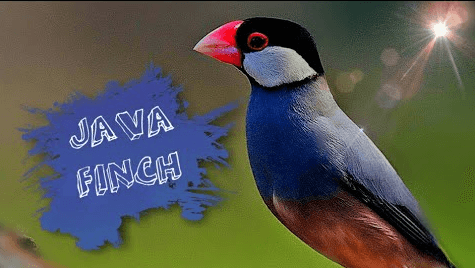
The lovely Java finch, which is little, elegant, and calm, has been popular as a cage and aviary bird for several years. These birds demand a "hands-off" attitude to bird management, making them an excellent choice for new and old bird owners looking for an easy-to-care-for bird. Their graceful in-cage flight maneuvers and relaxing songs make them one of the most fascinating little birds to own and observe. However, you may require two or three; they require the companionship of other finches. The Java sparrow was precisely defined in 1758 in the 10th version of Carl Linnaeus' Systema Naturae, classified under the binomial name Loxia oryzivora. The particular epithet blends the Latin Oryza, which means "rice," with the suffix -virus, which means "eating." Linnaeus based his characterization on the "Padda or Rice-bird" recorded and portrayed by the English scientist George Edwards in his study titled as A Natural History of Uncommon Birds in 1743. Edwards thought his specimens were from China, yet he cites the common name "Java sparrow." 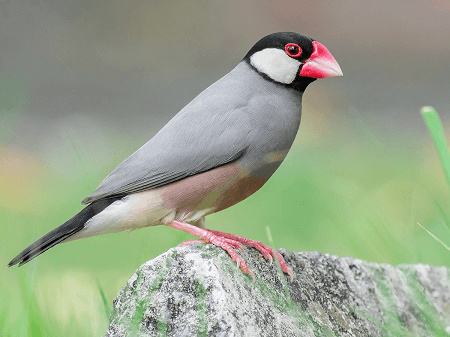
Description Of The Java BirdThe Java sparrow is around 15 to 17 cm (5.9 to 6.7 in) long from the end of its tail feathers to the end of its beak. Although it is only around the dimensions of a house sparrow, it is thought to be the largest animal in the estrildid family. The average body mass is 24.5 g (0.86 oz), making it incredibly bulkier than the black-bellied seedeater, its closest known rival. The mature bird is recognizable with its gray upperparts and breast, with the pink abdomen, white-cheeked black head, red eye-ring, pink feet, and large red beak. Both genders are comparable. Immature birds have brownish upper parts and pale brown underparts, as well as a simple head. The beaks of young birds are black with a pink foundation. The sound is a chip, and the melody is a quick series of call sounds chip chip chip. NatureJava finches are small, gregarious birds that are typically far too shy to connect directly with humans. However, some pet owners have experienced success in connecting with their Java birds. They often flourish in pairs or petty flocks contained within a flight cage. Java Birds should not be kept as solitary pets. If they are alone and without an additional finch to keep them entertained, they will get depressed in major situations. Aside from that, these birds are calm, gentle, and non-aggressive. They may coexist peacefully with various species of finches, both large and little. A pair of Java birds can be an excellent inclusion to any aviary. They only express hostility between two male Javas, and it is typically minor even then. Speech, Sounds, and SongThe Java finch has highly soothing vocalizations and a distinct chip-chip-chip song. Males woo females with melodies that contain drum-like clicking sounds with their beaks, and this is akin to how we humans perform beatboxes or clap their hands to a tune. 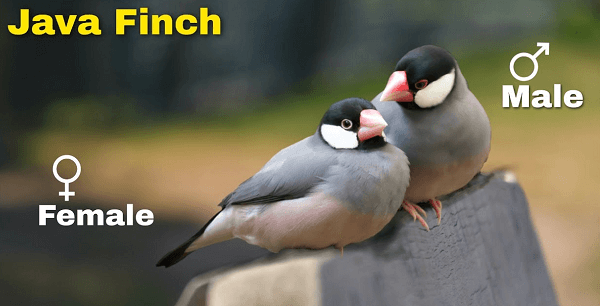
History and OriginsThe Java finch is indigenous to the Indonesian islands of Java, Bali, and Bawean, as the names indicate. In addition, they can be spotted in Sri Lanka, Hawaii, Jamaica, and Puerto Rico. This bird is a threatened species in Java. On grasslands and savannas, this Asiatic sparrow often dwells in big flocks. The birds have developed a taste for cultivated areas, especially those that grow rice. Farmers on several of the bird's native islands regard it as a pest. The species are prohibited in several locations where they are not indigenous. The feral population, if they emerge, poses a risk to local agriculture. The Java sparrow was brought to the Indian subcontinent, but it was unable to establish itself on the Indian mainland.&n Breeding numbers can be found in the United States on the various Hawaiian Islands, including Oahu. The Java sparrow was brought to the Caribbean and is now pretty prevalent near San Juan. It has also been spotted in Jamaica, but none of the other islands are known to have it. It was also brought to Christmas Island, which is situated at a distance, off the coast of Western Australia. HabitatThe Java bird is a friendly bird that mostly feasts on grain and other grains. It prefers open grassland and cultivation and was once a pest in rice fields, therefore the etymology. The nest is built in a tree or structure, and up to 8 eggs are placed. 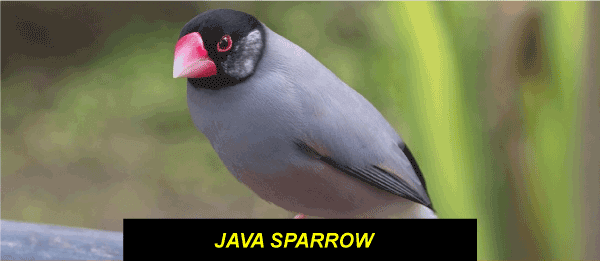
Java Bird - Colours and AppearanceThe Java bird has a natural coloring, including a grey back and black head and tail feathers. Their breasts and tummies are grayish-cinnamon in hue, and they have huge white markings on their cheeks. Some individuals equate them to miniature penguins. The Java finch's small orange ring surrounding their eyes is yet another distinctive feature. These birds have vivid orange skin on their legs and feet, as well as vivid red to orange colored beaks. Male birds and female birds of the subspecies have the same plumage color combination. There are a few techniques to determine the sexes differently, but without a side-by-side contrast, it's difficult. Males, for example, have dark pupils and a larger, blunter beak that expands at the front during the breeding season. The best way to tell which of these finches is singing is to glance at which birdie is humming. Only the males sing while the females call. Males may take a while to sing; after a week of seclusion, most will, according to some observers. If you keep a flock of birds, distinguishing between them can be tough, but it is possible with careful attention and labeling. Java sparrow color variations are common in the pet trade. Pied javas, black-headed javas, cinnamon or fawn javas, dark silver and light silver javas, and white javas are some examples of these. 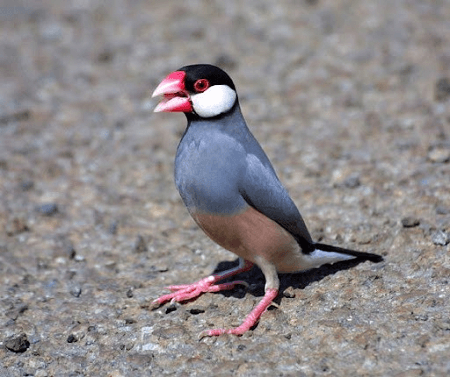
Caring Of Java BirdDue to their small size, these birds have become widely popular pet birds among those with limited seating and who are unable to keep a bigger species of birds. If you're considering about getting a Java bird, you should be prepared to take in at least two or three. The cage needed for Java birds should be spacious enough to facilitate flying and will vary depending on how many birds you have. In general, a 7-foot-high aviary would be perfect. If you are unable to keep an aviary, you would need a cage that has the dimensions of atleast18 inches width by 30 inches length by 18 inches height, with 1/4-inch to 1/2-inch bar spacing. Unless you intend to reproduce the birds, nesting boxes are not required. To keep them interested, offer plenty of perch, staircases, swings, and toys. They enjoy bathing as well. As a result, a bowl of water, for this reason, would be very valued. Java birds are prolific breeders who will reproduce all year unless when it is too hot or cold. If you want to maintain a non-breeding aviary, same-sex pairs are your perfect hope. Eliminate any nesting boxes or eggs that have been placed as a substitute. Plant false eggs as decoys to guarantee your female does not endanger her health by constantly laying an egg to restore her "lost" eggs. 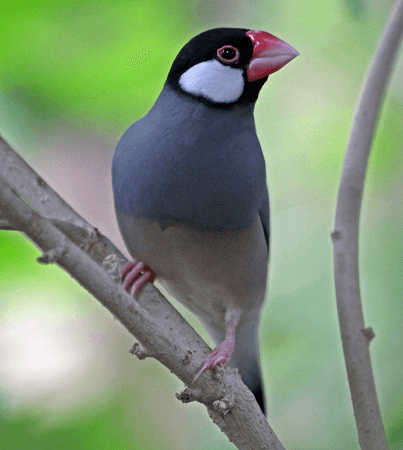
Common Health IssuesJava birds are recognized to be relatively hardy species that rarely get unwell if proper care is taken for. A proper and balanced diet minimizes the chances of nutrient problems. They, like any other bird, are susceptible to a variety of avian diseases transmitted by other birds, such as: Aspergillosis is a fungal infection. Bacteriological infections Polyomavirus is a highly deadly virus. Before bringing a new bird to your birdcage, it is always preferable to isolate your species for 6 weeks and watch for any signs of problems. Diet and Nutrition Of Java BirdThe java birds are well-known for eating rice in the wild, but still, their average diet comprises of seeds along with various types of fruits. Java birds in captivity should be given the highest seed mix. Each day, give your birds one to two teaspoons of high-quality birdseed mix and a spoonful of a specially made pellet diet. 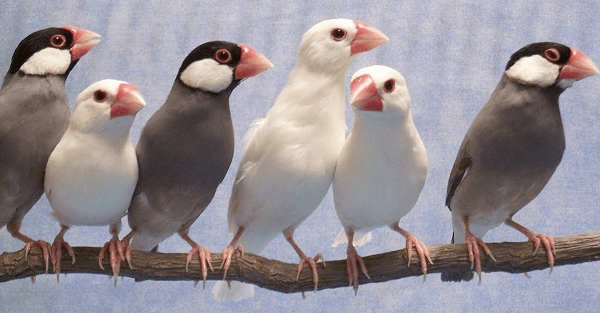
Many keepers of Java birds report success with feeding them parakeet prepared mixes instead of finch food. Java birds will remove or choose seeds as per their choice and make big chaos, so it's crucial to tailor the diet to what they will consume. Add nuts, grains, and finely diced, bird-safe fruits and veggies to their seed mix and pellets. Chopped egg or oyster shells, which are high in calcium, will also be enjoyed by your birds, and the majority of javas dislikes cuttlebones. ExerciseThese are highly busy small birds with almost limitless energy, as do all bird species. So, make sure to have a cage that supports their flying, playing, climbing, jumping, and exercising in a tall flight cage. These birds are wonderful pets for individuals who don't have enough time to connect and engage with a parrot or other bird; they don't need to be played with outside the cage. They're terrific at amusing themselves as long as they have other birds as well as plenty of toys. 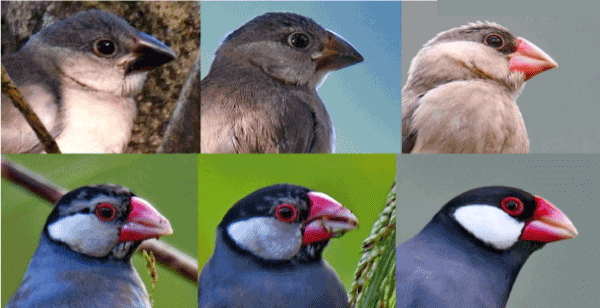
ThreatsSome countries view the Java sparrow to be an agricultural nuisance in rice farming. Natural habitat degradation, hunting in some regions, and capturing (as a pest) in others have resulted in substantially lower numbers in the wild, and observations in its native environment have become rarer and rarer. This Java bird is currently considered endangered on the IUCN Red List of Threatened Species and is classified on CITES Appendix II. As per TRAFFIC, the bird is also gravely threatened by the illicit exotic pet trade since they are sought after for their unusual singing.
Next TopicJava Island
|
 For Videos Join Our Youtube Channel: Join Now
For Videos Join Our Youtube Channel: Join Now
Feedback
- Send your Feedback to [email protected]
Help Others, Please Share










